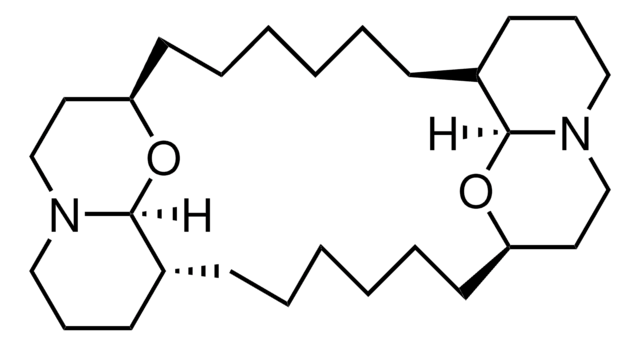239805
Cyclopiazonic Acid, Penicillium cyclopium
A cell-permeable, reversible inhibitor of sarcoplasmic reticulum Ca2+-ATPase that releases Ca2+ from the same intracellular pools as Thapsigargin.
Synonym(s):
Cyclopiazonic Acid, Penicillium cyclopium, CPA
About This Item
Recommended Products
Quality Level
assay
≥97% (TLC)
form
solid
manufacturer/tradename
Calbiochem®
storage condition
OK to freeze
color
off-white
solubility
DMSO: 1 mg/mL
chloroform: 10 mg/mL
shipped in
ambient
storage temp.
−20°C
InChI
1S/C20H20N2O3/c1-9(23)14-18(24)17-16-11-8-21-13-6-4-5-10(15(11)13)7-12(16)20(2,3)22(17)19(14)25/h4-6,8,12,16-17,21,25H,7H2,1-3H3/t12-,16+,17+/m1/s1
InChI key
RLOAZVAJNNPPDI-DQYPLSBCSA-N
General description
Biochem/physiol Actions
Ca2+ uptake in cultured arterial musclue cells
Warning
Reconstitution
Other Notes
Elmoselli, A.B., et al. 1995. Mol. Cell. Biochem. 151, 149.
Schaefer, A., et al. 1994. J. Biol. Chem.269, 8786.
Demaurex, N., et al. 1992. J. Biol. Chem.267, 2318.
Low, A.M., et al. 1992. Am. J. Physiol.262, H31.
Kurebayashi, N., and Ogawa, Y. 1991. J. Muscle Res. Cell Motil.12, 355.
Mason, M.J., et al. 1991. J. Biol. Chem.266, 20856.
Legal Information
signalword
Danger
hcodes
Hazard Classifications
Acute Tox. 2 Oral
Storage Class
6.1A - Combustible acute toxic Cat. 1 and 2 / very toxic hazardous materials
wgk_germany
WGK 3
flash_point_f
Not applicable
flash_point_c
Not applicable
Certificates of Analysis (COA)
Search for Certificates of Analysis (COA) by entering the products Lot/Batch Number. Lot and Batch Numbers can be found on a product’s label following the words ‘Lot’ or ‘Batch’.
Already Own This Product?
Find documentation for the products that you have recently purchased in the Document Library.
Our team of scientists has experience in all areas of research including Life Science, Material Science, Chemical Synthesis, Chromatography, Analytical and many others.
Contact Technical Service








